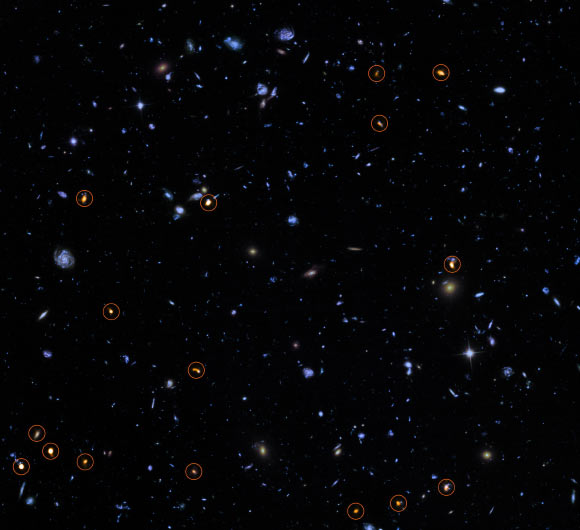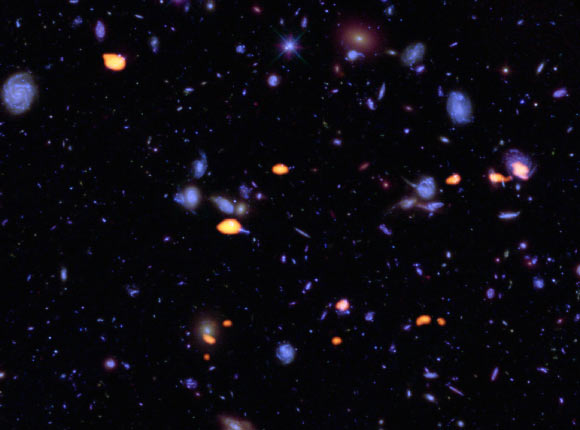Astronomers using the Atacama Large Millimeter/submillimeter Array have explored the same corner of the early Universe first revealed in the iconic image of the Hubble Ultra Deep Field, a galaxy-rich region of space in the constellation Fornax.

This image combines a background picture taken by Hubble (blue/green) with a new very deep ALMA view of this field (orange, marked with circles). All the objects that ALMA sees appear to be massive star-forming galaxies. Image credit: ALMA / ESO / NAOJ / NRAO / NASA / ESA / J. Dunlop et al / S. Beckwith, STScI / HUDF Team.
In 2004 the Hubble Ultra Deep Field (HUDF) images – pioneering deep-field observations with the NASA/ESA Hubble Space Telescope – were published. These spectacular pictures probed more deeply than ever before and revealed a menagerie of galaxies stretching back to less than a billion years after the Big Bang.
Unlike Hubble, which studies visible and infrared light from bright cosmic objects like stars and galaxies, the Atacama Large Millimeter/submillimeter Array (ALMA) studies the faint millimeter-wavelength light emitted by cold gas and dust, the raw material of star formation.
ALMA’s ability to see a completely different portion of the electromagnetic spectrum allows astronomers to study a different class of astronomical objects, such as massive star-forming clouds and protoplanetary disks, as well as objects that are too faint to observe in visible light.
A team of astronomers led by University of Edinburgh scientist Jim Dunlop used ALMA to obtain a deep, homogeneous image of a region as large as the HUDF. This data allowed them to clearly match up the galaxies that they detected with objects already seen with Hubble and other telescopes.
This study showed clearly for the first time that the stellar mass of a galaxy is the best predictor of star formation rate in the high redshift Universe. They detected essentially all of the high-mass galaxies and virtually nothing else.
“This is a breakthrough result. For the first time we are properly connecting the visible and UV light view of the distant Universe from Hubble and far-infrared/millimeter views of the Universe from ALMA,” Dr. Dunlop said.

A trove of galaxies, rich in carbon monoxide (indicating star-forming potential) were imaged by ALMA (orange) in the Hubble Ultra Deep Field. The blue features are galaxies imaged by Hubble. Image credit: B. Saxton / NRAO / AUI / NSF / ALMA / ESO / NAOJ / NASA / ESA / Hubble.
Another research team, led by Manuel Aravena of the Diego Portales University in Chile, and Fabian Walter of the Max Planck Institute for Astronomy in Germany, conducted a deeper search across about one sixth of the total HUDF.
“We conducted the first fully blind, three-dimensional search for cool gas in the early Universe. Through this, we discovered a population of galaxies that is not clearly evident in any other deep surveys of the sky,” said Dr. Chris Carilli of the National Radio Astronomy Observatory.
Some of the new ALMA observations were specifically tailored to detect galaxies that are rich in carbon monoxide, indicating regions primed for star formation.
Even though these molecular gas reservoirs give rise to the star formation activity in galaxies, they are often very hard to see with Hubble.
ALMA can therefore reveal the ‘missing half’ of the galaxy formation and evolution process.
“The new ALMA results imply a rapidly rising gas content in galaxies as we look back further in time,” Dr. Aravena said.
“This increasing gas content is likely the root cause for the remarkable increase in star formation rates during the peak epoch of galaxy formation, some 10 billion years ago.”
The new results will be published in a series of papers appearing in the Astrophysical Journal and the Monthly Notices of the Royal Astronomical Society.
_____







